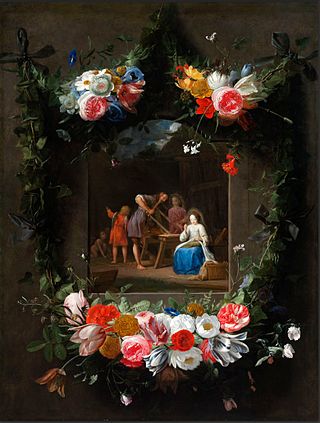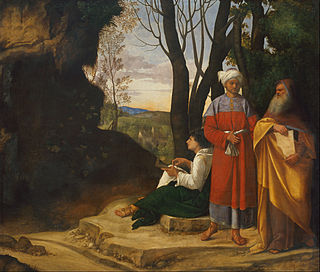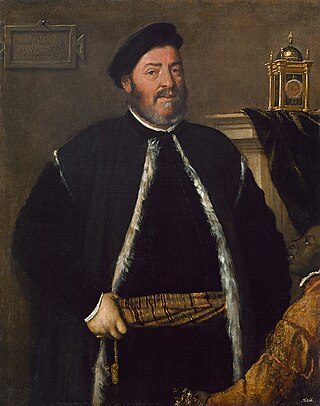

Saint Margaret and the Dragon is the title shared by two paintings of Saint Margaret by the Renaissance painter Raphael, both executed in about 1518. One is held in the Kunsthistorisches Museum in Vienna, the other in the Louvre in Paris. [1]


Saint Margaret and the Dragon is the title shared by two paintings of Saint Margaret by the Renaissance painter Raphael, both executed in about 1518. One is held in the Kunsthistorisches Museum in Vienna, the other in the Louvre in Paris. [1]
The painting shows the saint at the moment before she is swallowed alive by the dragon. She is shown unafraid, holding the crucifix that will save her once she is swallowed.
This painting was documented in David Teniers the Younger's catalog Theatrum Pictorium of the art collection of Archduke Leopold Wilhelm in 1659 and again in 1673, [2] but the portrait had already enjoyed notoriety in Teniers' portrayals of the Archduke's art collection.
Another version showing the central figure holding a palm branch is in the collection of the Louvre.

Nikolaas van Hoy, known in Austria as Nikolaus van Hoy was a Flemish Baroque painter, draughtsman and etcher.

The Three Philosophers is an oil painting on canvas attributed to the Italian High Renaissance artist Giorgione. It shows three philosophers – one young, one middle-aged, and one old. The work was commissioned by the Venetian noble Taddeo Contarini, a Venetian merchant with an interest in the occult and alchemy. The Three Philosophers was finished one year before the painter died. One of Giorgione’s last paintings, it is now displayed at the Kunsthistorisches Museum in Vienna. The painting was finished by Sebastiano del Piombo.

The Stallburg is a renaissance-style building in the Vienna city center located between Josefsplatz and Michaelerplatz. It is part of the Hofburg Palace.

Violante is an oil painting attributed to Titian, dated to around 1515 and now held at the Kunsthistorisches Museum in Vienna.

The Portrait of Jacopo Strada is a 1567-68 portrait of the court librarian Jacopo Strada by Titian, now held in the Kunsthistorisches Museum in Vienna.

The Madonna of the Cherries is a 1515 painting by Titian, heavily influenced by the work of Giovanni Bellini. Originally oil on wood, it was later transferred to canvas. During the 17th century it formed part of the collection of Archduke Leopold Wilhelm, where it was copied by David Teniers. It is now in the Kunsthistorisches Museum in Vienna.

Theatrum Pictorium, or Theatre of Painting, is a short-hand name of a book published in the 1660s by David Teniers the Younger for his employer, the Archduke Leopold Wilhelm of Austria. It catalogs 243 Italian paintings in the Archduke's collection of over 1300 paintings. The paintings are reproduced by engravings made by various engravers after reduced-size copies (modelli) created by Teniers. David Teniers' brother Abraham Teniers was involved in organizing the publication of the work. A second edition with page numbers was published in 1673.

Jan van Troyen was a Flemish engraver and etcher. He is mainly known for the work he did for David Teniers the Younger on the illustrations for the Theatrum Pictorium, an publication which gave an overview of the paintings in the collection of the Archduke Leopold Wilhelm.

Judith with the head of Holofernes is a 1610–1615 painting by the painter Carlo Saraceni, now held in the Kunsthistorisches Museum in Vienna.

Gallery of Archduke Leopold Wilhelm in Brussels is a 1651 painting of Archduke Leopold Wilhelm's Italian art collection by the Flemish Baroque painter David Teniers the Younger, now held in Petworth House in England.

The Archduke Leopold Wilhelm in his Painting Gallery in Brussels is a 1651 painting of Archduke Leopold Wilhelm's Italian art collection by the Flemish Baroque painter David Teniers the Younger, now held in the Prado in Madrid.

Archduke Leopold Wilhelm and the artist in the archducal picture gallery in Brussels is a 1651 painting of Archduke Leopold Wilhelm's Italian art collection by the Flemish Baroque painter David Teniers the Younger, now held in the Kunsthistorisches Museum in Vienna.

Archduke Leopold Wilhelm and the artist in the archducal picture gallery in Brussels is a 1653 painting of Archduke Leopold Wilhelm's Italian art collection by the Flemish Baroque painter David Teniers the Younger. It is now held in a private collection, but it was previously owned by the Rothschild family, from whom it was taken in World War II and placed in the Kunsthistorisches Museum where it stayed for 50 years until restitution in 1999.

Archduke Leopold Wilhelm and the artist in the archducal picture gallery in Brussels is a 1653 painting of Archduke Leopold Wilhelm's Italian art collection by the Flemish Baroque painter David Teniers the Younger, now held in the collection of Museo Lázaro Galdiano in Madrid.

Gallery of Archduke Leopold Wilhelm in Brussels is a 1651 painting of Archduke Leopold Wilhelm's Italian art collection by the Flemish Baroque painter David Teniers the Younger, now in the Royal Museums of Fine Arts of Belgium.

Gallery of Archduke Leopold Wilhelm in Brussels is a painting of Archduke Leopold Wilhelm's Italian art collection by the Flemish Baroque painter David Teniers the Younger, now held in the Schleissheim Palace. It dates to the 1650s.

Nymph and Shepherd, also called Shepherd and Nymph, is an oil painting by the Venetian master Titian, made about 1570. The painting is in the collection of the Kunsthistorisches Museum in Vienna.

Portrait of Fabrizio Salvaresio is an oil painting by Titian. It is signed and dated 1558, and hangs today in the Kunsthistorisches Museum in Vienna.

The Mary with Child and Saints Stephen, Jerome and Mauritius, also called the Virgin with Three Saints, is a religious painting by Titian which hangs in the Kunsthistorisches Museum in Vienna.

Christ and the Adulteress, also titled Christ and the Woman Taken in Adultery, or The Adulteress before Christ, is an oil painting by Titian, made about 1520, in the Kunsthistorisches Museum, Vienna.